Perhaps you’ve heard rumblings, perhaps you know, or perhaps you haven’t a clue that a plethora of Greenbrier artists crank out masterpieces on a daily basis. All connected by a common thread of creativity, they generate works of art that titillate the senses and offer pure joy. The following four will participate in the Arts and Crafts Exhibit at the Emerald on Sunday, August 18, as will many others.
Billie Ruth Sudduth
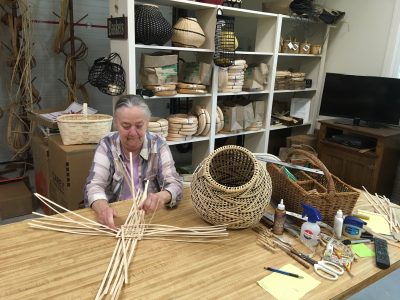
Growing up in the South, Billie Ruth Sudduth never saw a silver tea set in her home but did observe interesting baskets. The women responsible also sewed, knitted and crocheted, but the girl hated needles and thread. “In college, I would substitute staples or Scotch Tape, and thank goodness now my husband can sew on a button.”
Fast-forward to the early ‘80s after a particularly demanding year as a Craven County school psychologist. Mentally exhausted, the therapist chose to do something for fun so, recalling the artful baskets from her youth, Billie Ruth enrolled in a basket-weaving class at Craven Community College. Whoa! Within minutes, she experienced an epiphany, a realization that making baskets would change her life.
Well-versed in math and statistics, Billie Ruth immediately became bored with the over-and-under aspect of basketry and embraced a 1-1-2-3 weaving sequence. ”Little did I know then that those are the first four numbers of the Fibonacci sequence.” (Italian mathematician Leonardo of Pisa AKA Fibonacci developed the sequence in the 13th Century.) Employing the Golden Ratio, she mirrored proportions in human anatomy, nature and even the universe.
Acknowledging that she “gets” all that heady stuff because she is a psychologist, Billie Ruth pared it all down to a mere-mortal level by explaining that until people told her, she didn’t know that she was elevating a basket to a higher level. Her collectors called her pieces “baskets with a brain” and when people respond to her work, the artist believes she is “doing subliminal advertising.”
In 1985, Billie Ruth quit her job and moved with the family to Las Vegas, intent on making baskets for a living and although she returned to psychology, she never stopped creating. After a move to Wilmington, the craftswoman quit work entirely and participated in high-end shows. That paid off because the Sudduths then moved to the Asheville area, a hot-bed for arts and crafts, where the curator for the renowned Smithsonian requested one of her baskets. That black-and-tan masterpiece now sits in the hallowed institute, and more are displayed in other museums and fine art institutions.
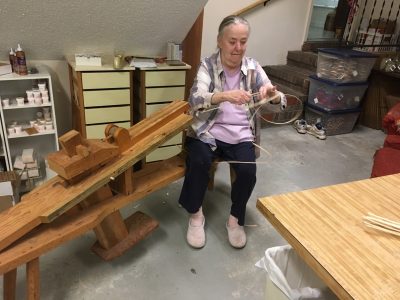 Moreover, Billie Ruth was the first female to be dubbed a Living Treasure by the state of NC, the highest honor in crafts, and was named to the Order of the Long Leaf Pine, the highest honor awarded by NC Governors. She is also an author and media personality.
Moreover, Billie Ruth was the first female to be dubbed a Living Treasure by the state of NC, the highest honor in crafts, and was named to the Order of the Long Leaf Pine, the highest honor awarded by NC Governors. She is also an author and media personality.
Her tightly-woven pieces are unique and magnificent, with Billie Ruth often incorporating the color red, rarely seen in baskets. “Actually, it’s crimson because I’m a University of Alabama alumnus!” She utilizes black too, evidenced by the piece in the Smithsonian, and concocts all her own dyes. Creating in her garage/studio, the artist works on a shave horse and carves with a draw knife.
Appearing as comfortable in her plaid shirt as she did in her own skin, the self-assured woman summed up her contribution to basketry by explaining, “I took baskets to a higher level that duplicates nature, and I’ve been getting them off the floor and onto pedestals ever since.”
(On etsy.com see Just a Bunch of Baskets or go to brsbasket.com)
Chuck Jensen
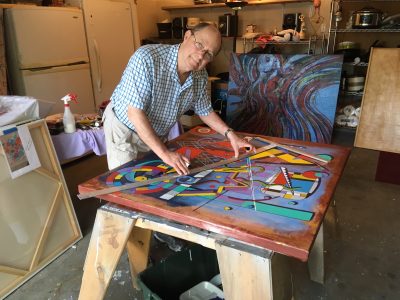 Next gallops in live-wire Chuck Jensen, with larger-than-life canvasses and a never-meets-a-stranger persona. The artist’s studio/garage is where he creates contemporary works and portraits, always with music in the background. Chuck explained that the manner in which good musicians interpret music, especially jazz, parallels what he does when he paints. “The paintings and the music talk to you.”
Next gallops in live-wire Chuck Jensen, with larger-than-life canvasses and a never-meets-a-stranger persona. The artist’s studio/garage is where he creates contemporary works and portraits, always with music in the background. Chuck explained that the manner in which good musicians interpret music, especially jazz, parallels what he does when he paints. “The paintings and the music talk to you.”
From ceiling to floor, the walls of the Jensen home are brimming with Chuck’s bold, usually abstract, large canvasses – sometimes multiple (triptych). Color, shape and sound (his music) fill the senses. Two are named “Herbert’s Sherbert” and “Carnation Vacation”.
His portrait of the winningest women’s basketball coach (TN) in the U.S. is displayed at the Pat Summitt Foundation in Knoxville, and California Congresswoman Jacki Speier commissioned him to paint her portrait, which now hangs in her Capitol Hill office. “Thanks Vince” is displayed in the Children’s Cancer Center of the Cookeville, TN Regional Hospital, and other canvasses are at the Bank of the Arts, The Stage at Nashville, local medical facilities and at the Wilson Moose Lodge.
His favorite painting? “Always the one I’m working on,” currently a piece inspired by Wassily Karasinsky, a Russian painter from the Bauhaus in Germany, dubbed the pioneer of abstract art. Karasinsky incorporated straight lines, curves, circles and gradations of color - and so does Chuck.
In the Illinois farm town where Chuck grew up, the only type of art offered was welding in an FFA class. However, everyone knew the boy-wonder was talented and fortunately, a high school mentor embraced him. She wrote letters and voilá, the Art Institute of Chicago accepted him in the ‘60s. “I never did mind-altering drugs. My friends all said, ‘He don’t need to get stoned; he’s high all the time!’” After looking strongly at fine art as a profession, the artist reconsidered and went with interior design, focusing on office, restaurant and hotel space.
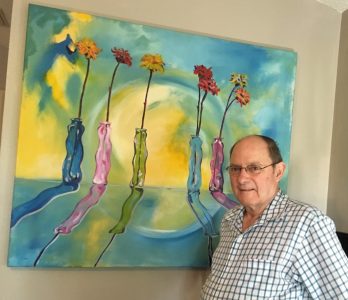
Not only does Chuck’s artistry adorn his walls but it’s evident throughout the entire house, which he and wife Bev transformed into a masterpiece. Bright, contemporary rugs hug the floors, and gutting the kitchen allowed them to create a work of art in that space that vividly shouts, “Look at me! There’s not another kitchen like me in the world.”
Back to the music, it’s as essential to Chuck’s creativity as breathing is to life. Fascinated with music of all types, he loves the grandeur of strings in How the Wes Was Won and easily switches gears to country-and-blues artist Delbert McClinton. Chuck’s favorite is Ahmad Jamal, a jazz pianist who interprets music in much the same manner that Chuck creates art. “He doesn’t know the outcome of his piece any more than I know the outcome of mine. If I wanted to know how my art would turn out, I’d paint by numbers.”
Chuck enjoys New Bern because it’s artful, and the people are genuine. Moving from a non-progressive area of Tennessee to here, he chose a place where people appreciate his art.
His thoughts about artists? “We didn’t choose to create art; it chose us. So don’t fear the end results; embrace the gift.”
(See www.cjensendesigns1225.net.)
George Hunter

Modest George Hunter ambles in next, with award-winning landscape and still life canvasses that combine a representational and plein air (painting in outdoor light) style.
After a career with the Federal Aviation Administration, George moved away from the frenetic energy of the business world to pursue a degree in psychology, landing in Colorado. Often enjoying philosophical discussions with a friend who “could chat and paint at the same time,” George watched and thought, “I can do that,” which turned out to be more difficult than he imagined. “My people looked like stick figures, and there was no depth or quality.” Yet he enjoyed painting and read many instructional books, learning the importance of the basic rules and techniques which govern drawing and painting, such as composition, perspective and color theory.
“There were about a million things to learn and the artist must paint a lot, which I don’t do - maybe once a week.” Regardless, his pieces please the senses and foster serenity. A while back, the Hunters stayed a month in an Italian farm house, south of Florence, and he painted both the house and the view of a castle out the window, both tasteful and finely crafted. Appropriate frames complement the pieces, and he buys those online.
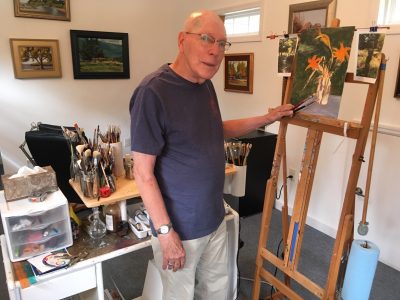
In 2006, George retired from his psychology practice and moved with his wife to New Bern, where he continues to paint in an upstairs studio. While essentially self-taught, he credits local painter, Janet Dixon, with helping him become a respectable artist, showing in local and regional juried shows. His love of nature’s rich colors, textures and forms produces a distinctive, creative expression in his art. Rural landscapes and Eastern Carolina seascapes are favorite subjects, with attention to light and color, and George especially loves painting old tobacco barns and local farm scenes.
Recognizing a parallel between painting and psychology, the artist explained that in order to help clients, he needed to be creative in solving problems by providing appropriate structure and execution, just as he does in his artwork. “I can make an approximation between creating art and helping someone struggling with psychological distress. A successful outcome in each results in a form of healing and beauty.”
All said and done, laid-back George Hunter loves painting but considers it a hobby, not something he takes too seriously. He implored, “Don’t write too much about me.”
Cal Hansen
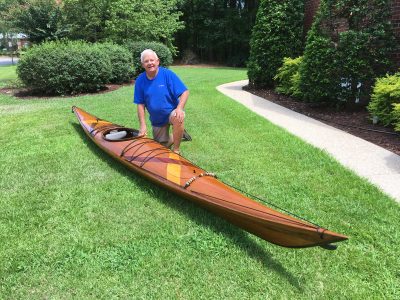
Last but not least charges in Cal Hansen, firing creatively from two barrels: mapping uncharted waterways and building kayaks.
After years of sailing, Cal and wife Carol landed in historic New Bern. Coming from the Midwest, where he was an engineer with International Harvester, they chose the “Gem of the East Coast” because of access to the ocean; they chose Greenbrier because of spying a sign on Hwy. 70 touting a new golf community. “Not many houses were built in here then.”
Cal worked at the Maritime Museum in Beaufort for a few years, but the love of water beckoned the couple again. While kayaking nearby streams and rivers, they were amazed to find 100s of miles of county waterways that were uncharted for the paddling community. As he and other paddling friends explored, Cal recorded the journeys and documented the adventures.
About that time (2005), Cal and paddling buddy Bill Sadler founded the Twin Rivers Paddle Club, with support from the Craven County Parks and Recreation Dep’t. (Members now number more than 100.) “Yet I had an ulterior motive.” Because of professional advertising brochures that lured him to kayak other areas, the gung-ho guy hoped to publish something similar, documenting the uncharted waterways and designating Craven County and New Bern as destinations.
Surgery interrupted his plans so what did Cal do? While recuperating, he created an online brochure detailing 25 paddle trips in the county. See https://cravencounty.recdesk. com/ Community/Page?pageld=2186.
Back to his quest. Armed with the new club, the county’s help, credentials and a network, Cal enlisted help from the Craven County Tourism Board. Bingo! The professionally done Twin River Paddle Trails brochure came to fruition and is now available at the Tourism Information Center. Funds were appropriated from city, county and state park grants as well as other sponsors.
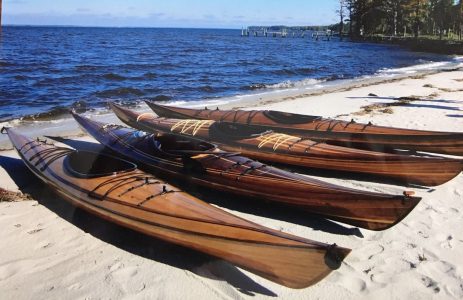
Cal’s next adventure? Painstakingly crafting kayaks. Using western red cedar trimmed in Peruvian walnut and Alaskan yellow cedar for the first one, he then constructed one for Carol choosing local juniper and walnut. The kayak pictured in the yard took at least 1,500 hour of labor and is finished with strips 1/2”x1/8”x18’, using a table saw, router, hand plane and piles of sandpaper. Incorporating 60-70 clamps, the artist employed Elmer’s Glue to marry the strips together and fiberglassed the thing inside and out.
After creating two more and selling them to friends, Cal said, “I call it a day.” However, it sure is fun to draw a crowd when launching his masterpiece. People ask if he carved it out of one log, reminiscent of cavemen and Indians gouging out a dugout with an ax. Others comment on the artistic beauty and craftsmanship. Cal spent over 1,500 hours creating the last one, earning about 25-50 cents an hour. “That’s not even minimum wage, folks!”
Artistry comes in all forms so there you have Cal Hansen, a renowned Greenbrier cartographer and boat builder. Wonder what he’ll tackle next.
About the author: Bonnie Burch was a newspaper journalist/copy editor for 18 years in Texas before reluctantly moving to New Bern to be by family because her husband had Alzheimer's. He has since died, and she believes this magical town is the perfect place to retire. Adios Texas!
